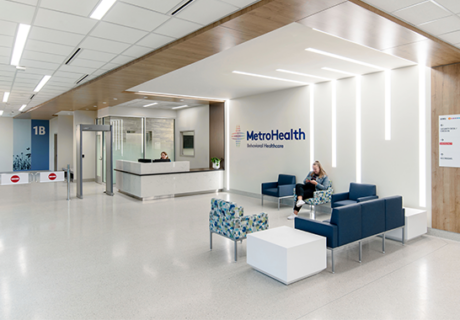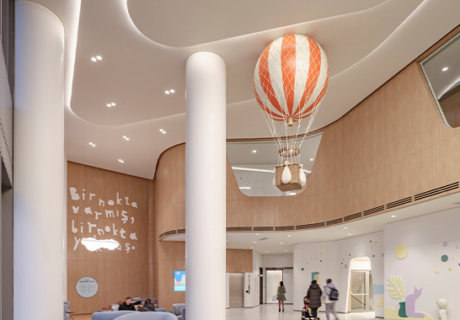Brain Power At UC Gardener Neuroscience Institute
Patients being treated at the University of Cincinnati Gardner Neuroscience Institute may encounter several obstacles on their way to an appointment. For example, many patients rely on walkers or wheelchairs to get around, which makes navigating ramps, doorways, and parking garages difficult. For others, certain neurologic conditions cause sensitivities to light, colors, and patterns that could cause vertigo or disorientation.
So when the opportunity came to build a new outpatient facility for the institute and its 13 centers of excellence, including the Gardner Center for Parkinson’s Disease and Movement Disorders and The Waddell Center for Multiple Sclerosis, the project team set out to better understand those challenges before ever putting pen to paper.
“We had different patient groups who represented different neurologic problems, and we said, ‘OK, what is your experience of care within the existing facility and what would be the ideal state for you?’” says Dr. Joe Broderick, director of the UC Gardner Neuroscience Institute and professor of neurology and rehabilitation medicine at UC Health.
At the time, the institute, part of the UC Health academic medical center campus in Cincinnati, had services spread across multiple buildings, a sloped parking facility, lack of dedicated therapy space, and an infusion department that had been retrofitted into existing space. “We had a lot of issues in a lot of ways,” Broderick says. “Our staff was very good, but we just didn’t have the environment that made it easy for patients.”
The goal was to use input from patients, families, and staff to design a patient-centered environment focused on the unique needs of neurological patients while providing a focal point for clinical care, education, and research on campus. “It was all about patients and families finding a home for their neurological conditions, where they can get treated and educated about their disease and interact with the other patients,” says Jerry Johnson, design principal at Perkins and Will (Chicago), which provided architecture and interior design services on the project.
From parking to exam room
The project team looked at the design through the perspective of both patients and families, conducting multiple meetings with an advisory committee.
“It opened up the conversation to much broader, deeper aspects,” says Eve Edelstein, director of Perkins and Will’s Human Experience Lab (San Francisco). “We heard about everything from how dramatically difficult it is for someone with a neurological disorder to find a parking spot to getting into the building in a timely manner and their need to access a toilet quickly, all of which can make the journey to the hospital a horrific experience.”
As a result, design considerations had to start from the moment families arrive on campus, with navigating the building from the garage to the clinic floor presenting one of the first challenges they may face. Specifically, some patients have balance disorders that make it difficult to navigate the slope of a garage, while those with mobility issues or who rely on a wheelchair or ambulatory device such as a walker or cane can be impacted by everything from the spacing of parking stalls to the distance from the garage to clinic entrances. The solution for the new institute was to incorporate a two-story garage under the building with flat floors for parking and a drive-only ramp connecting the two levels and wider parking stalls. Inside the building, seating in the wider corridors is available for those who need to rest briefly en route to their appointment. To further ease a patient’s arrival to their final destination, the building is designed so that once patients know their way into the building, they don’t have to stop off at the lobby for directions but can take the elevator straight to their clinic floor to check in.
Additionally, the project team recognized that some patients travel long distances to receive treatment and have been in the car for hours, so access to bathrooms was another hot topic, Johnson says. Patients shared their desire to have bathrooms conveniently placed and large enough to accommodate family members in case they need assistance.
“There are bathrooms located right near elevators,” he says, as well as throughout the clinic areas. They feature sliding doors that are easy to maneuver and seating for caregivers.
Designers also considered how certain interior design elements could negatively affect patients inside the 114,000-square-foot, four-story facility. For example, patients expressed their dislike of soaring atriums that are a common feature in medical buildings.
“Some patients with neurocognitive disorders find those kinds of spaces disorienting or they can cause vertigo,” Johnson says. Here, the solution was to utilize large windows, daylighting, and light materials to provide an open and airy feeling on the first floor but without the volume. And because bold patterns and reflective surfaces can be challenging for those with sensory or motor issues, designers chose a neutral color and materials palette with warm wood accents.
The building, which opened in April 2019, also features specific treatment areas for patients, such as a first-floor rehabilitation suite for physical therapy appointments and an Activities of Daily Living suite, which offers an apartment-like setting where patients can re-learn everyday tasks and skills, such as laundry or dish washing. A second-floor infusion suite offers options in treatment settings, including an open area, flexible spaces with partitions, and private rooms with adjustable lighting.
Another project goal was to support collaboration among the multidisciplinary staff. Using a modular design, each specialty has its own clinic pod—housed on the second, third, and fourth floors. Open staff areas in the center of the pods give clinicians direct sight lines to patients and exam rooms, while additional semi-can meet. Because some specialties see patients only during certain hours or days, the clinics feature similar exam room layouts so they can flex into adjoining pods during peak demand. Designers also chose to exceed the typical exam room size to ensure rooms could accommodate patients arriving with multiple caregivers and the larger-sized clinician teams typical at an academic medical center.
“We couldn’t have the smallest minimum because of our patient needs and the types of services that the doctors and nurses provide,” Edelstein says. Additionally, furnishings and equipment are designed to be moved around the room or be removed to accommodate different tests and services, minimizing how often patients are moved during a visit.
Exterior statement
Because the project would consolidate most of the institute’s services under one roof, as well as mark the first new building on campus in three decades, UC wanted “a gateway building to give a new face to the medical center,” Johnson says. Further raising the bar, the adjoining UC college campus is known for several “starchitect” buildings, including a sculptural lab building designed by Frank Gehry across the street from the new neuroscience institute.
Still, the project team knew it had to consider how the façade would impact patients’ experience within the interior environments.
For example, while providing access to daylighting and outdoor views was important to support circadian rhythms, “high-contrast lighting was not desirable because some patients are extremely sensitive to bright or contrasting light/glare,” Johnson says.
To diffuse the natural light coming in, the project team considered a variety of solar screens, including wood and metal, before choosing a structural façade with a frame wrapped in a pattern of tensile mesh. The scrim is applied to the upper three levels on the west, south, and east sides of the building that receive direct sunlight, while a glass curtain wall was utilized on the north side. The 3-D sunshade fabric system diffuses light into the building, minimizing glare, and reduces the solar load by 56 percent. The organic shape and patterning in the fabric was inspired by folds in the brain lobes “without being too literal,” Johnson adds, while the base of the building, housing the parking levels, is covered in limestone and creates a plinth in which the building sits.
Positive impression
Reflecting on the project, Broderick attributes much of the success to the team’s ability to understand the expressed needs and desires of patients and families and translate that to the design. “Sometimes patients are coming in, and it’s not for a half-hour appointment; they may see the doctor, get therapy, and go to imaging. They could be there for two, three, or four hours,” he says. “They want to have a great environment that’s quiet, calm, and peaceful, even between appointments.”
That meant no detail was too small, from the extra attention paid in the parking garage to the abundance of natural light to the style of doors on the bathrooms and exam rooms.
“It’s a very different environment,” Broderick says. “We wanted to make it a great experience for the families as well as the patients.”
Project details:
Project name: University of Cincinnati Gardner Neuroscience Institute
Project completion date: April 2019
Owner: University of Cincinnati Health
Total building area: 194,351 gross sq. ft.
Total construction cost: $51.4 million
Cost/sq. ft.: approx. $265
Architecture: Perkins and Will
Interior design: Perkins and Will
General contractor: Messer Construction
Engineering: Shell + Meyer Associates, Inc. (structural); Heapy Engineering (mechanical and electrical),
The Kleingers Group (civil)
Construction Manager: Hplex Solutions
Art/pictures: Gardner Family Foundation, Perkins and Will
Carpet/flooring: Ceramic Technics Ltd., Stonhard, Forbo, Kinetex, Formica, Corian, Martina Bros.
Acoustical ceilings: Armstrong, Rulon
Doors/locks/hardware: Pioneer Cladding & Glazing Systems (entrances), Wilson Partitions (sliding doors), Assa Abloy (locksets)
Furniture—seating/casegoods: Haworth, Krug, Knoll, KI, Herman Miller, Via
Tables: Haworth, OFS, Herman Miller, Versteel, Carolina, ERG, Krug, HBF
Upholstery: Carnegie, Knoll, Maharam, HBF, Stinson, Xorel, Architex
Handrails/wall guards: Altro, CS Acrovyn
Lighting: Lithonia, Metalux Daybright, Edison Price, Lumenpulse, Kenall Healthcare, Cree, Lutron
Signage/wayfinding: Perkins and Will
Tensile Mesh: Valmex façade by Mehler Texnologies/Structurflex
Rainscreen MCM Panels: Morin
Curtain Wall: Pioneer Cladding & Glazing System
Project details are provided by the design team and not vetted by Healthcare Design.
Anne DiNardo is executive editor of Healthcare Design. She can be reached at anne.dinardo@emeraldx.com.









